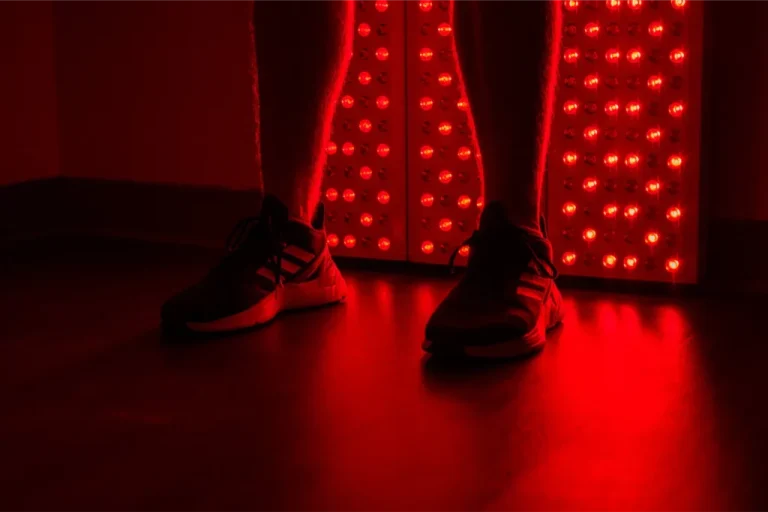What type of Red Light Therapy is offered at Planet Fitness?
Does Planet Fitness Have Red Light Therapy?
Absolutely! The red light therapy machine, also known as Total Body Enhancement (TBE), is a perk offered by Planet Fitness to its Black Card members. From improving skin texture to aiding post-workout muscle recovery, the benefits seem to cover a lot.
However, it’s not available at all locations. Since the choice to offer red light therapy is usually made by each franchise, it’s best to ask your local Planet Fitness if they have it.
What Is Red Light Therapy at Planet Fitness?
To begin with, let’s talk about the basics of light and its biological machanism on the human body. Just like plants, our bodies react to light and absorb it to fuel a range of biological functions. So for example, when your skin is exposed to sunlight, it makes vitamin D. This happens due to the interaction of UVB rays with a protein called 7-DHC in your skin.
Also, it’s widely known that blue light can affect our circadian rhythms and sleep quality. Both UV light and blue light are part of the five “biologically active” spectra, alongside far-infrared, red, and near-infrared light. These lights, each with its own wavelength, go into the body at different depths and affect it in different ways.
An Overview of Medical Light Therapy
Light therapy was employed to avoid scarring from smallpox1 by physician and scientist Niels Ryberg Finsen in the late 1800s. In 1910, a book titled “Light Therapeutics” featured John Harvey Kellogg’s research and writing on the benefits of red light and infrared heat. Then, Endre Mester, a pioneer of laser medicine, observed that laser light could stimulate hair growth and speed up wound healing in rats in 1967.
It was not until the 1980s that NASA scientists began using red LED lights to stimulate plant growth during space missions. They also observed that scratches on their hands seemed to heal quicker than expected while working with their hands under the LED arrays2.
What is Red Light Therapy?
RLT, which people also call Photobiomodulation(PBM), typically involves placing a light source near or in direct contact with the skin. As such, the light photons are absorbed by the mitochondria3 within cells. Research indicates that PBM is effective in treating conditions resulting from cancer therapies, including alopecia, ulcers, herpes simplex virus, acne, skin rejuvenation, wounds, and scars4.
From handheld gadgets to face masks and LED helmets, RLT devices come in many shapes and sizes. Usually applied to alleviate pain, inflammation, and stiffness, these gadgets vary by coverage area, power level, and wavelength combination, and some add electrical stimulation or magnetic fields to increase light absorption. In our case, gym-goers access healing photons through the Planet Fitness Total Body Enhancement unit.
Other terms commonly used to describe red light therapy are:
- Photobiomodulation
- Non-thermal LED light
- Low-power laser therapy
- Soft laser therapy
- Low-level laser light therapy
- Biostimulation, photonic stimulation
- Cold laser therapy
So, how does Red Light Therapy work?
Simply put, Red Light Therapy centers on the notion that RED and NIR (near-infrared) lights can activate the body’s innate ability to heal itself5.
But how? A study led by Glen Jeffery, PhD, at University College London’s Institute of Ophthalmology may shed some light on it. In this study, a specially modified LED flashlight was utilized by Dr. Jeffery’s team. The researchers administered a three-minute dose of deep red light to the retinas of 20 subjects, whose ages ranged from 38 to 70 years. Finally, Dr. Jeffery’s group discovered that deep red wavelength (670 nm) enhances the energy production of dysfunctional mitochondria.
Nanometer (nm) is the unit used to measure wavelength.
It’s all about the mitochondria.
Mitochondria, found in animals, plants, fungi, and us, are tiny structures that produce the chemical energy required to maintain normal cellular function. Take the muscle, for instance—it houses numerous mitochondria. The liver is similar in this regard, as is the kidney. Even the brain, to some extent, relies on that energy to function at its best6.
Clearly, mitochondria are like tiny power plants in your cells. Therefore, mitochondrial dysfunction is regarded as a primary factor in the decline of physical function and the onset of various noncommunicable chronic illnesses such as cardiovascular diseases7. When your body’s inflamed, it can mess up your mitochondria. Stress, injury, and illness can also throw a wrench in your mitochondria’s normal function.
To sum up, red light therapy improves mitochondrial function to benefit cell survival.
What does Red Light Therapy do to Mitochondria?
Now you may wonder: how do mitochondria respond to red light treatment?
In fact, the “CcO theory,” proposed by Tiina Karu in the 1990s8, is the most universally acknowledged explanation for the therapeutic effects of red light treatment. The mechanism is like this: when light interacts with cells, it first affects the redox-active copper atoms in a specific protein complex in mitochondria, called CcO. And this CcO (Cytochrome c Oxidase) absorbs light, particularly the red and near-infrared range of the light spectrum.
Karu found that different light-induced changes in cells, like DNA and RNA production and cell attachment, happened at the same light wavelengths. This suggested there might be a common cellular component that absorbs these wavelengths and triggers changes in the cell. The key light wavelengths were in the blue (404 nm), red (620 and 680 nm), and near-infrared (760 and 820 nm) parts of the spectrum.
To be exact, mitochondria absorb particular wavelengths of light and that’s the trigger of everything. Similar to how plants harness sunlight for energy, stimulation of the mitochondria creates adenosine triphosphate (ATP).
Energy at the cellular level is primarily sourced from adenosine triphosphate (ATP), which is utilized and stored as needed.
What Determines Red Light Therapy Efficacy?
In general, how well red light therapy works depends on different parameters, such as light wavelength range, the energy source (LED or diode-laser), irradiance, fluence, time, and treatment sessions. Among them, researchers discuss and experiment with the wavelength of light the most. It influences the penetration depth into the tissues and thus induces specific biological effects.
Wavelength dictates how deeply light travels into the body.
Let’s keep in mind that the longer the wavelength, the deeper the penetration into the body. As per a study reported in October 2023, Red light in the 600 to 650 nm range would be limited to the deep dermis-reticular and hypodermis layers, with a penetration depth of 4.0 to 4.5 mm9. On the other hand, NIR light (700 to 750 nm) would extend beyond the hypodermis, reaching deeper tissues in thicker skin areas such as acral regions.
It is also well-accepted that shorter wavelengths are ideal for superficial tissue treatment, while longer wavelengths are favored for deeper tissues. Infrared wavelengths, in particular, are superior for bone repair because they penetrate more deeply than red light10.
What does Planet Fitness Red Light Therapy do?
Glad you asked. According to Planet Fitness, the Total Body Enhancement machine shines red light mainly in the 620 to 700 nanometer range. The primary wavelength is 630 nm.
What does this spectrum do to our body? Let’s first take a look at the manufacturer behind the Planet Fitness RTL unit: The Beauty Angel website claims that their product offers “cosmetic stimulation of the skin using photobiomodulation.” Also, Planet Fitness says customers should see better skin and anti-aging benefits in 90 days. They recommend using it for 12-minute sessions, 2-3 times a week, with a 24-hour gap between two consecutive sessions.
We got you. Now it comes down to one question: Does it truly deliver?
Skin Rejuvenation
The good news is that red (625-700 nm) and infrared (700-1100 nm) indeed represent the typical light spectrum utilized in dermatology practice11. In 2010, a study treated 21 patients with 630 nm light12 and pulsed light after microneedling and ALA incubation. Researchers then observed improvement in fine lines, mottled pigmentation, sallowness, tactile roughness, and telangiectasias at 3 and 6 months compared to baseline assessments. Additionally, 90% of patients reported over 50% improvement at 6 months.
On the other hand, a 2022 review published in the National Library of Medicine13 mentioned that red light treatment reduces swelling, makes skin cells grow faster, helps blood vessels grow, creates new tissue, and boosts collagen production. The method is to expose human tendon fibroblast cells to 20 minutes of light using 630 nm and 630 nm + 880 nm LED.
Now, it seems that Planet Fitness does feature the beneficial light wave for improving skin health. In fact, many of its members have reported seeing changes in skin texture after using their red light therapy.
But there’s more to consider…
I’m far from a tech enthusiast; to be honest, I spent several days going through dozens of papers to gather the information above. Despite all the parameters and data presented, these studies still seem dubious to me. Maybe, as Paul Ingraham suggests, there’s a bit too much “mechanism masturbation” going on.
Check out Jonathan Jarry’s hot tweet:
“There is a fascinating phenomenon in the CAM literature we could call ‘mechanism masturbation’ where the authors, faced with the tiniest of positive signals in a small study, write paragraph after paragraph hypothesizing how, mechanistically, watermelon seeds might cure schizophrenia.”
It’s also worth noting that most people funding, conducting, and writing these papers are from red light panel companies and their advisory board members.
Certainly, we should take into account the actual experiences shared by Planet Fitness Red Light Therapy users. Among them, I find two comments both genuine and fascinating. The first comment acknowledges the positive effects on the body after use: smoother, perhaps firmer skin. But it’s also true that this reviewer has made significant lifestyle changes recently: a healthier diet, no alcohol, lots of water, and regular exercise…
Yes, if you ask me, I’d say these new habits are more likely responsible for the toned skin and body than the PF red light treatment.
In another review, a loyal Planet Fitness member cleverly cited his instructor’s response about the effectiveness of wrinkle creams: When using beauty products, instructions often tell you to massage the area with your fingers, and it’s this massage that might actually be working. The wrinkle area benefits from increased blood flow due to the massage.
This reminds me that in Eastern medicine, massages are often combined with pressure points to achieve desired effects. In other words, even without the Planet Fitness RLT machine, we can reap all those rewards, and even more, that maintaining a fitness routine provides.
Planet Fitness Red Light Therapy FAQs
Can Planet Fitness Total Body Enhancement help with weight loss?
In short, NO.
You might come across bloggers and the brand saying: “It helps with fat burning.” In reality, medical experts haven’t reached a consensus on how red light specifically triggers weight loss. There’s a lack of large-scale clinical studies and long-term data to support its effectiveness.
Next, let’s consider: What’s involved in weight loss? — Diet, exercise, and many healthy lifestyle choices. As mentioned earlier, attributing weight loss to one single factor is unrealistic.
That’s why it’s often recommend using the machine after exercise rather than before. To finish off, here’s a Reddit quote I personally like: “It doesn’t make sense – if there was a definite tool/product that caused fat loss they would market the **** out of it (for that purpose).”
- https://www.nature.com/articles/075560b0 ↩︎
- https://spinoff.nasa.gov/NASA-Research-Illuminates-Medical-Uses-of-Light ↩︎
- https://www.ncbi.nlm.nih.gov/pmc/articles/PMC5844808/ ↩︎
- https://www.jaad.org/article/S0190-9622(24)00187-7/abstract#back-bib134 ↩︎
- https://www.sciencedirect.com/topics/biochemistry-genetics-and-molecular-biology/photobiomodulation ↩︎
- https://www.genome.gov/genetics-glossary/Mitochondria ↩︎
- https://www.ncbi.nlm.nih.gov/pmc/articles/PMC7255501/ ↩︎
- https://www.ncbi.nlm.nih.gov/pmc/articles/PMC6685747/ ↩︎
- https://www.sciencedirect.com/science/article/pii/S2666469023000386 ↩︎
- https://www.ncbi.nlm.nih.gov/pmc/articles/PMC8355782/ ↩︎
- https://academic.oup.com/asj/article/43/5/NP357/7018419 ↩︎
- https://onlinelibrary.wiley.com/doi/abs/10.1002/lsm.20905 ↩︎
- https://www.ncbi.nlm.nih.gov/pmc/articles/PMC9880516/ ↩︎







